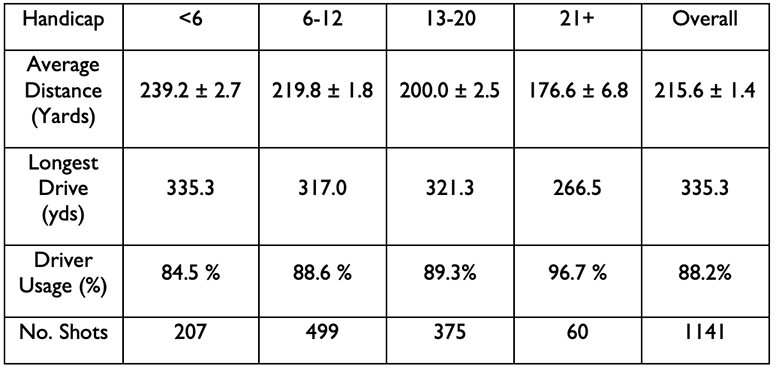Understanding Average Driver Distance To Maximize Golf Swing

As a golf novice, you might often ask yourself questions like “how far should I hit with the driver?” or “What is the average driver distance?”
The average driving accuracy for a golfer off the tee is around 60%-70% for males and 50%-60% for females. This accuracy is affected by the golfer’s technique, the type of club used, and the quality of the strike.
This article is crucial for golf enthusiasts as it explains the average driving distances and some tips you can employ in your golf game.
I. Average driving distance by age
For golfers under 30 years, the ball drives at 238 yards on average. However, with each decade of experience, this distance decreases by 10 yards. Nevertheless, the general average for all age groups is 219 yards.
Here is a table that mentions the average driver distance with respect to age.
| Age range | Average driver distance |
| 20-30 | 238 yards |
| 30-40 | 231 yards |
| 40-50 | 220 yards |
| 50-60 | 211 yards |
| 60+ | 196 yards |
| All golfers | 219 yards |
II. Average driving distance by handicap
Average golf driving distance based on a handicap refers to an average score of 18 holes. A scratch golfer can shoot around par on average, while a 10-handicap golfer will shoot 82 (or a little worse) on a par 72 golf course.
The average driving range for a golfer with 5 handicap or lower is 250 yards. This might seem diminutive to some, yet it’s a realistic figure for someone who isn’t a pro. If golfers hit the golf ball at that average distance, then their skill level stands fairly close to the standard of even-scratch golfers!
The below shot scope data represents the handicap range with respect to average driving distances.
| Handicap Range | Average Driver Distance |
| Under 5 | 250 yards |
| 5-10 | 231 yards |
| 10-19 | 215 yards |
| 19-28 | 195 yards |
| Over 28 | 177 yards |
III. How far does the average golfer drive the ball?
Generally, each golfer has a distinct distance that they hit with different types of golf clubs. The ability to drive varies depending on multiple factors, including club and ball selection, environmental conditions, age/gender, swing speed, and more.
After years of examination, The R&A and USGA in 2020 released a wide-range and detailed review of driving distance.
This comprehensive report delves into the driving distance of major professional golf tours such as the PGA TOUR, European Tour, Japan Golf Tour, Korn Ferry Tour, PGA TOUR Champions Tour, LPGA Tour, and Ladies European tour.
IV. Driver distance charts
The Tour Player Averages Chart tracks professional players’ averages, while the USGA Amateur Male and Female Charts track amateur golfers’ performance. Utilize these charts as a roadmap for measuring progress in improving your driving distances and to know the average golfer driving distance.
1. Tour Averages

The Tour Chart displays the driver distance averages for multiple Professional Golf Tours worldwide. Notably, the below stats mention the men’s PGA tour average and women’s LPGA average for driver distance.
- In 2003, the average driving distance for PGA tour players was 277 yards. 18 years later, in 2021, that number has risen to 289 yards – a remarkable 12-yard improvement!
- Since 2003, the LPGA tour has steadily increased its average driver distance from 249 yards to 257 yards––a total rise of 7 yards.
2. USGA Amateur golfers – Male

The chart above demonstrates the average driving distances of amateur male golfers based on the player’s handicap. It is clear that those with a lower handicap (<6) hit farther drives, averaging 240 yards each shot and using the driver 84.5% of their time off the tee.
This proves that even though these players opt for other clubs in the beginning, they still manage to consistently outdrive higher-handicapped golfers in this area of technique. Of course, this depends on the hole layout.
By comparison, a higher-handicap golfer (21+) typically drives an average of 177 yards and opts for the driver 96.7% of the time on each tee shot.
All in all, the nationwide average male golfer hits a driver distance of 216 yards in total distance.
3. USGA Amateur golfers – female

This chart clearly illustrates the average driving distances for women on the basis of handicap. Notably, players with a lower handicap (<6) can hit an impressive 196 yards on average and choose to use their driver 97.4% of the time off the tee. This suggests that depending on the hole layout, golfers can use other clubs based on the shot they want to hit.
In contrast, the higher handicap player (29+) averages about 119 yards and uses the driver 94.8% of the time off the tee. Overall, the average driver in America for all women is 147 yards.
V. How is the average driving distance measured?
Professional golf was greatly impacted by the Covid-19 pandemic in 2020, including a decrease in the number of shots tracked. Typically, two holes on each tournament course are measured for driving distance – resulting in up to 40,000 strokes being recorded over one season on some tours.
However, with fewer events held this past year due to pandemic restrictions, there has been a notable reduction of drives that have been monitored and calculated overall.
In 2020, on tours with measured data, the average decrease in figures was 33% lower than in 2019. Notably, 95-96 percent of PGA TOUR and European Tour players use a driver to hit at every hole where driving distance is being measured, no matter their rank driving distance.
VI. What is a good drive distance?
While there isn’t a single driver distance that fits all golfers, you can use the average of recreational golfers to get an idea of what could be considered good for your own skill level and equipment.
Generally speaking, average golfers typically hit between 195-205 yards with their drivers. As always, it’s important to remember that different factors will cause this number to vary from player to player.
VII. Tips and techniques
There are a few tips and techniques to keep in mind to improve your driving distance.
- Focus on technique rather than strength.
- Make sure that you have the proper grip and stance when setting up to hit a drive.
- When making the downswing, utilize a slower body weight to transition from back to front.
- Additionally, build up your core and leg strength, as these are key components for powering your shot.
- Use a club with the correct loft angle and spin rate. This can be determined by consulting with a PGA professional or testing different clubs.
- Lastly, practice regularly and ensure you warm up before each session.
- With patience and dedication, you’ll be able to maximize your driving distance in no time!
Conclusion
In conclusion, the average driving distance for male and female golfers varies depending on factors such as skill level and type of equipment used. These charts could be used as a good gauge to measure the progress of your own performance.
However, improving your driving distance isn’t easy, but it’s worth the effort when you see the results in your game. Try different techniques and practice regularly to find out which works best for you!








